
LOADING ...
In response to evolving domestic opinion, eMedals Inc has made the conscious decision to remove the presentation of German Third Reich historical artifacts from our online catalogue. For three decades, eMedals Inc has made an effort to preserve history in all its forms. As historians and researchers, we have managed sensitive articles and materials with the greatest of care and respect for their past and present social context. We acknowledge the growing sentiments put forth by the Canadian public and have taken proactive actions to address this opinion.
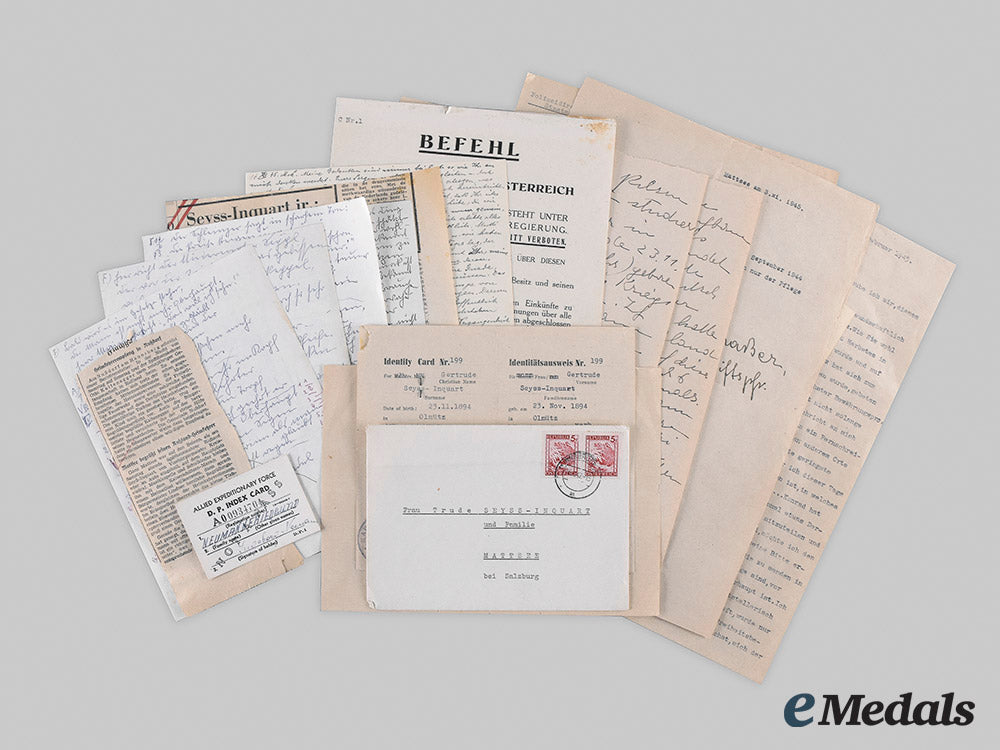
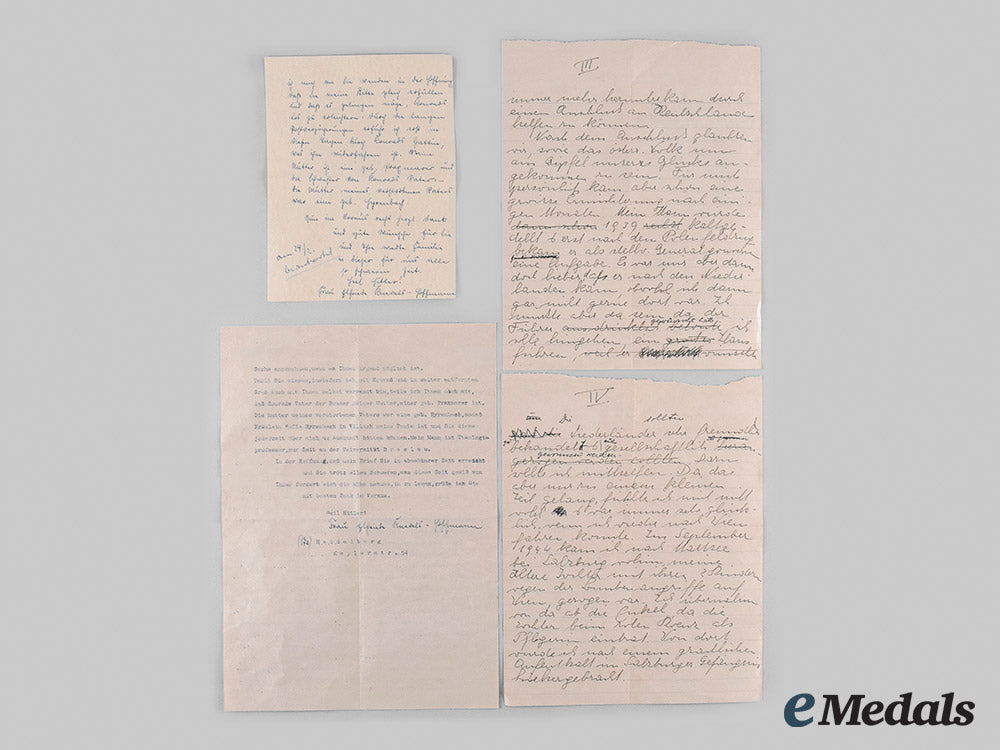

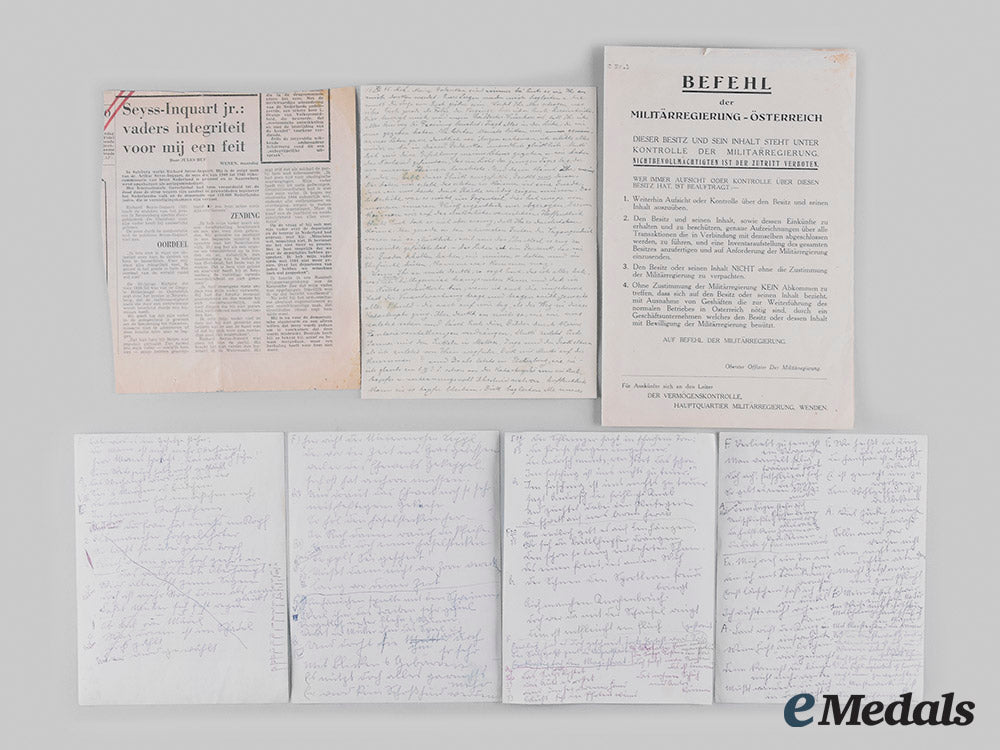

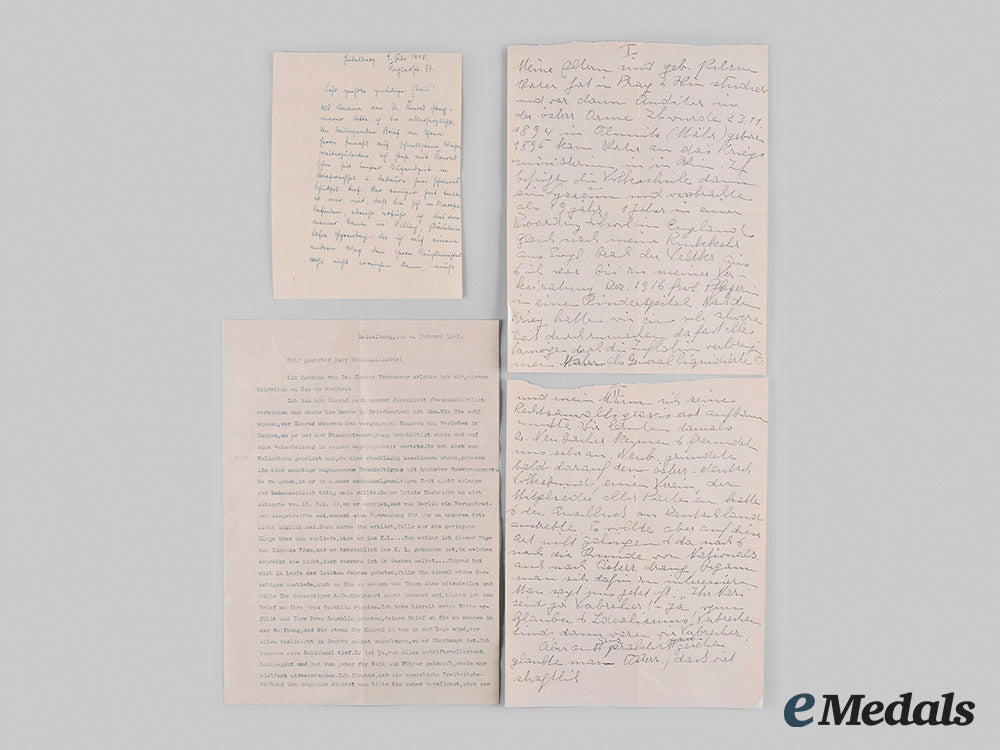
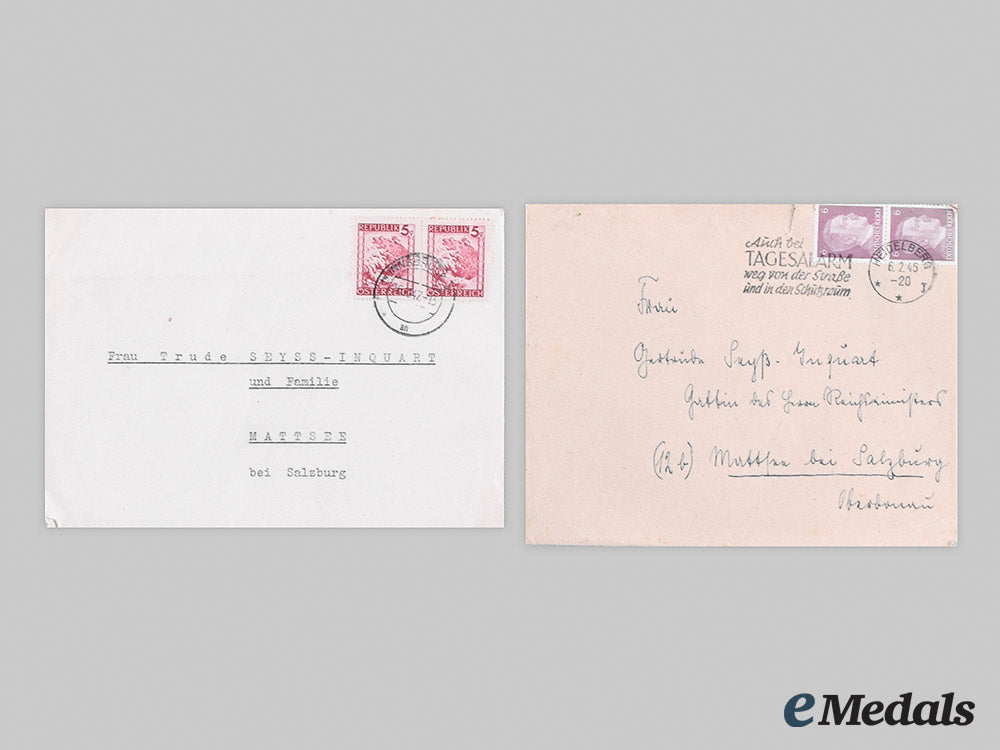
Germany, Nsdap. A Lot Of Documents From The Estate Of Seyß-Inquart
Germany, Nsdap. A Lot Of Documents From The Estate Of Seyß-Inquart
SKU: ITEM: G45773
Current Bid:
Your Max Bid:
Bid History:
Time Remaining:
Couldn't load pickup availability
Shipping Details
Shipping Details
eMedals offers rapid domestic and international shipping. Orders received prior to 12:00pm (EST) will be shipped on the same business day.* Orders placed on Canadian Federal holidays will be dispatched the subsequent business day. Courier tracking numbers are provided for all shipments. All items purchased from eMedals can be returned for a full monetary refund or merchandise credit, providing the criteria presented in our Terms & Conditions are met. *Please note that the addition of a COA may impact dispatch time.
Shipping Details
eMedals offers rapid domestic and international shipping. Orders received prior to 12:00pm (EST) will be shipped on the same business day.* Orders placed on Canadian Federal holidays will be dispatched the subsequent business day. Courier tracking numbers are provided for all shipments. All items purchased from eMedals can be returned for a full monetary refund or merchandise credit, providing the criteria presented in our Terms & Conditions are met. *Please note that the addition of a COA may impact dispatch time.
Description
Description
The grouping consists of: A post-war photo ID card in English and German to wife of Arthur Seyß-Inquart, Gertrude, dated to Mattsee (Austria) on August 29, 1945. The photo shows her in a Red Cross nurse’s uniform.
Measuring 170 mm (w) x 150 mm (h), presenting two folding creases and a small rip on the upper left side, remains very fine.
Three displaced person index cards of the Allied expeditionary force, one to Gertrude Seyß-Inquart, one to Richard Neumann, and one to Ingeborg Neumann.
Measuring 76 mm (w) x 51 mm (h), presenting virtually no damage or signs of aging, remaining near mint.
Autobiographical notes by Gertrude Seyß-Inquart on two handwritten pages.
Measuring 200 mm (w) x 255 mm (h), presenting two folding creases and uneven tearing at the top, remaining better than fine.
A letter and envelope sent to Arthur Seyß-Inquart with accompanying letter to Gertrude Seyß-Inquart from Elfriede K.-Hoffmann, cousin of author Dr. Konrad Praxmarer, in turn cousin of Gertrude. Dated to February 4, 1945. After having heard that Praxmarer has been interned in a concentration camp, Elfriede writes to the Seyß-Inquarts, hoping that they can help him out.
Measuring 211 mm (w) x 296 mm (h) and 145 mm (w) x 189 mm (h), respectively, presenting two folding creases, remaining near extremely fine.
An envelope addressed to Trude Seyß-Inquart and family in Mattsee near Salzburg without a sender’s name, dated to October 16, 1947.
Measuring 160 mm (w) x 114 mm (h), presenting light creasing and fraying of the edges, remains near very fine.
A handwritten POW letter of unknown author to unknown recipients, dated to December 16, 1945.
Measuring 165 mm (w) x 219 mm (h), presenting two folding creases, light fraying of the edges, several small water stains, remains near very fine.
An order of the US military government in Austria, English and German, declaring that a certain property is under their control.
Measuring 176 mm (w) x 265 mm (h), presenting a folding crease, light creasing and fraying of the edges, and some discolouration in the upper right corner, remains near very fine.
A confirmation note stating that Gertrud Seyß-Inquart has officially registered as a resident of Mattsee, dated to August 22, 1945.
Measuring 208 mm (w) x 152 mm (h), presenting two folding creases and some fraying of the edges, remains near very fine.
A notification from the police department in Salzburg, asking Gertrude Seyß-Inquart to leave the greater Salzburg region due to reasons of public order and security. It is stated that since her location of permanent residence was Vienna, not Mattsee, Gertrude may not claim residence rights in the greater Salzburg area. Dated to October 25, 1945.
Measuring 212 mm (w) x 295 mm (h), presenting multiple folding creases and light overall creasing, remains very fine.
A certificate from the parish office in Mattsee, stating that Gertrude Seyß-Inquart has lived a quiet, orderly life in Mattsee since September 3, 1944. Dated to November 3, 1945.
Measuring 209 mm (w) x 296 mm (h), presenting two folding creases and light fraying of the edges, remains very fine.
A newspaper cutout of an article about the return of Richard Seyß-Inquart, Arthur’s son, from imprisonment in Russia in 1955. The author makes a point of saying that the past is the past, and there will be no dwelling on what has been.
Measuring 80 mm (w) x 170 mm (h), presenting a folding crease and uneven cutout marks with some fraying, remains better than fine.
An early 1970s Dutch newspaper article about Richard Seyß-Inquart.
Measuring 180 mm (w) x 210 mm (h), presenting a folding crease and uneven cutout marks with light fraying, remains better than fine.
Four handwritten and illegible pages.
Measuring 190 mm (w) x 148 mm (h), presenting light scuffing of the edges, remaining near extremely fine.
Footnote: Arthur Seyß-Inquart was born on July 22, 1892 in the village of Stannern (present-day Stonařov, southern Czech Republic) near the town of Iglau (Jihlava). This was a German speaking community within a Czech dominated area in Moravia, at the time part of the Austro-Hungarian empire. The family moved to Vienna in 1907.
Seyß-Inquart began to study law at the university of Vienna, and earned his degree during the First War in 1917 while recovering from being wounded. As a soldier in the Austro-Hungarian army he saw action in Russia, Romania, and Italy. He received several bravery decorations and at the end of the war held the rank of Oberleutnant (first lieutenant).
After the war, Seyß-Inquart developed close ties with several right wing and fascist organisations, among them the Vaterländische Front (Fatherland Front). He became a successful lawyer and had his own practice since 1921. In 1933, Seyß-Inquart went into Austrian politics and joined the cabinet of chancellor Engelbert Dollfuß.
Through growing influence and support by non other than A.H. himself, Seyß-Inquart eventually became Austrian Minister of the Interior in February of 1938. With the looming annexation of Austria by Germany in March of the same year, Austrian chancellor Schuschnigg stepped down. Seyß-Inquart was chosen as his successor due to immense pressure applied on the Austrian government by the NSDAP.
He served in this position for less than two days, until the Anschluss was completed. Seyß-Inquart signed the documents that legalised the annexation of Austria by Germany. After his office had ceased to exist, he was named Reichsstatthalter (Reich Governor) of the Ostmark, the newly created province that Austria had become as part of Greater Germany.
Being a fanatical anti-Semite, Seyß-Inquart almost immediately ordered the confiscation of Jewish property and had the Austrian Jews sent to concentration camps. He received the honorary SS rank of Gruppenführer in May of 1939, and would go on to become an SS-Obergruppenführer in 1941.
After the attack on Poland at the beginning of the Second War, Seyß-Inquart was named deputy to Hans Frank, the General Governor of occupied Poland. He supported Frank in the deportation of Polish Jews. Seyß-Inquart was also aware of the systematic murder of Polish intellectuals by the German secret service “Abwehr”.
In May of 1940, A.H. named Seyß-Inquart Reich Commissioner of the Netherlands. His policies concerning the Dutch Jews were no different than his policies had been concerning the Jews in Austria and Poland, in that they were ousted from governmental, and leading press and industry positions, their property seized, before being sent to concentration camps. Of the 140,000 Jews that were registered in the Netherlands in 1941, only 30,000 survived the war.
During his reign of terror, Seyß-Inquart also authorized the execution of at least 800 people, ranging from political prisoners to resistance fighters. At the end of the war, he was arrested by Allied forces and became one of the 24 defendants during the Nuremberg trials against the major war criminals. Seyß-Inquart was found guilty in three out of four charges and executed by hanging on October 16, 1946.
Description
The grouping consists of: A post-war photo ID card in English and German to wife of Arthur Seyß-Inquart, Gertrude, dated to Mattsee (Austria) on August 29, 1945. The photo shows her in a Red Cross nurse’s uniform.
Measuring 170 mm (w) x 150 mm (h), presenting two folding creases and a small rip on the upper left side, remains very fine.
Three displaced person index cards of the Allied expeditionary force, one to Gertrude Seyß-Inquart, one to Richard Neumann, and one to Ingeborg Neumann.
Measuring 76 mm (w) x 51 mm (h), presenting virtually no damage or signs of aging, remaining near mint.
Autobiographical notes by Gertrude Seyß-Inquart on two handwritten pages.
Measuring 200 mm (w) x 255 mm (h), presenting two folding creases and uneven tearing at the top, remaining better than fine.
A letter and envelope sent to Arthur Seyß-Inquart with accompanying letter to Gertrude Seyß-Inquart from Elfriede K.-Hoffmann, cousin of author Dr. Konrad Praxmarer, in turn cousin of Gertrude. Dated to February 4, 1945. After having heard that Praxmarer has been interned in a concentration camp, Elfriede writes to the Seyß-Inquarts, hoping that they can help him out.
Measuring 211 mm (w) x 296 mm (h) and 145 mm (w) x 189 mm (h), respectively, presenting two folding creases, remaining near extremely fine.
An envelope addressed to Trude Seyß-Inquart and family in Mattsee near Salzburg without a sender’s name, dated to October 16, 1947.
Measuring 160 mm (w) x 114 mm (h), presenting light creasing and fraying of the edges, remains near very fine.
A handwritten POW letter of unknown author to unknown recipients, dated to December 16, 1945.
Measuring 165 mm (w) x 219 mm (h), presenting two folding creases, light fraying of the edges, several small water stains, remains near very fine.
An order of the US military government in Austria, English and German, declaring that a certain property is under their control.
Measuring 176 mm (w) x 265 mm (h), presenting a folding crease, light creasing and fraying of the edges, and some discolouration in the upper right corner, remains near very fine.
A confirmation note stating that Gertrud Seyß-Inquart has officially registered as a resident of Mattsee, dated to August 22, 1945.
Measuring 208 mm (w) x 152 mm (h), presenting two folding creases and some fraying of the edges, remains near very fine.
A notification from the police department in Salzburg, asking Gertrude Seyß-Inquart to leave the greater Salzburg region due to reasons of public order and security. It is stated that since her location of permanent residence was Vienna, not Mattsee, Gertrude may not claim residence rights in the greater Salzburg area. Dated to October 25, 1945.
Measuring 212 mm (w) x 295 mm (h), presenting multiple folding creases and light overall creasing, remains very fine.
A certificate from the parish office in Mattsee, stating that Gertrude Seyß-Inquart has lived a quiet, orderly life in Mattsee since September 3, 1944. Dated to November 3, 1945.
Measuring 209 mm (w) x 296 mm (h), presenting two folding creases and light fraying of the edges, remains very fine.
A newspaper cutout of an article about the return of Richard Seyß-Inquart, Arthur’s son, from imprisonment in Russia in 1955. The author makes a point of saying that the past is the past, and there will be no dwelling on what has been.
Measuring 80 mm (w) x 170 mm (h), presenting a folding crease and uneven cutout marks with some fraying, remains better than fine.
An early 1970s Dutch newspaper article about Richard Seyß-Inquart.
Measuring 180 mm (w) x 210 mm (h), presenting a folding crease and uneven cutout marks with light fraying, remains better than fine.
Four handwritten and illegible pages.
Measuring 190 mm (w) x 148 mm (h), presenting light scuffing of the edges, remaining near extremely fine.
Footnote: Arthur Seyß-Inquart was born on July 22, 1892 in the village of Stannern (present-day Stonařov, southern Czech Republic) near the town of Iglau (Jihlava). This was a German speaking community within a Czech dominated area in Moravia, at the time part of the Austro-Hungarian empire. The family moved to Vienna in 1907.
Seyß-Inquart began to study law at the university of Vienna, and earned his degree during the First War in 1917 while recovering from being wounded. As a soldier in the Austro-Hungarian army he saw action in Russia, Romania, and Italy. He received several bravery decorations and at the end of the war held the rank of Oberleutnant (first lieutenant).
After the war, Seyß-Inquart developed close ties with several right wing and fascist organisations, among them the Vaterländische Front (Fatherland Front). He became a successful lawyer and had his own practice since 1921. In 1933, Seyß-Inquart went into Austrian politics and joined the cabinet of chancellor Engelbert Dollfuß.
Through growing influence and support by non other than A.H. himself, Seyß-Inquart eventually became Austrian Minister of the Interior in February of 1938. With the looming annexation of Austria by Germany in March of the same year, Austrian chancellor Schuschnigg stepped down. Seyß-Inquart was chosen as his successor due to immense pressure applied on the Austrian government by the NSDAP.
He served in this position for less than two days, until the Anschluss was completed. Seyß-Inquart signed the documents that legalised the annexation of Austria by Germany. After his office had ceased to exist, he was named Reichsstatthalter (Reich Governor) of the Ostmark, the newly created province that Austria had become as part of Greater Germany.
Being a fanatical anti-Semite, Seyß-Inquart almost immediately ordered the confiscation of Jewish property and had the Austrian Jews sent to concentration camps. He received the honorary SS rank of Gruppenführer in May of 1939, and would go on to become an SS-Obergruppenführer in 1941.
After the attack on Poland at the beginning of the Second War, Seyß-Inquart was named deputy to Hans Frank, the General Governor of occupied Poland. He supported Frank in the deportation of Polish Jews. Seyß-Inquart was also aware of the systematic murder of Polish intellectuals by the German secret service “Abwehr”.
In May of 1940, A.H. named Seyß-Inquart Reich Commissioner of the Netherlands. His policies concerning the Dutch Jews were no different than his policies had been concerning the Jews in Austria and Poland, in that they were ousted from governmental, and leading press and industry positions, their property seized, before being sent to concentration camps. Of the 140,000 Jews that were registered in the Netherlands in 1941, only 30,000 survived the war.
During his reign of terror, Seyß-Inquart also authorized the execution of at least 800 people, ranging from political prisoners to resistance fighters. At the end of the war, he was arrested by Allied forces and became one of the 24 defendants during the Nuremberg trials against the major war criminals. Seyß-Inquart was found guilty in three out of four charges and executed by hanging on October 16, 1946.







You May Also Like
Germany, SA. A Model 1933 Service Dagger, SA-Gruppe Nordsee, by Friedrich von der Kohlen
G59818
Germany, SA. A Model 1933 Service Dagger, SA-Gruppe Pommern, by Gustav Wirth
G59816
Germany, Third Reich. A Mixed Lot of Tyrolean Marksmanship Badges
G52930
Germany, SS. An Estonian Waffen-SS Volunteer’s Sleeve Shield
G50381
Germany, SS. A Waffen-SS Sturmmann Sleeve Insignia
G52846
-
Germany, SA. A Model 1933 Service Dagger, SA-Gruppe Nordsee, by Friedrich von der Kohlen
G59818
Add to CartRegular price $980 USDRegular price $0 USD Sale price $980 USDUnit price / per -
Germany, SA. A Model 1933 Service Dagger, SA-Gruppe Pommern, by Gustav Wirth
G59816
Add to CartRegular price $980 USDRegular price $0 USD Sale price $980 USDUnit price / per -
Germany, Third Reich. A Mixed Lot of Tyrolean Marksmanship Badges
G52930
Add to CartRegular price $135 USDRegular price $0 USD Sale price $135 USDUnit price / per -
Germany, SS. An Estonian Waffen-SS Volunteer’s Sleeve Shield
G50381
Add to CartRegular price $150 USDRegular price $0 USD Sale price $150 USDUnit price / per -
Germany, SS. A Waffen-SS Sturmmann Sleeve Insignia
G52846
Add to CartRegular price $135 USDRegular price $0 USD Sale price $135 USDUnit price / per
Do you have a similar item you are interested in selling?
Please complete the form and our client care representatives will contact you.
Sell Item


















